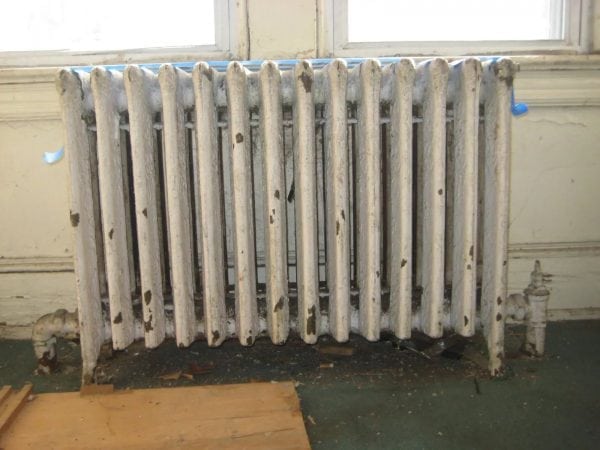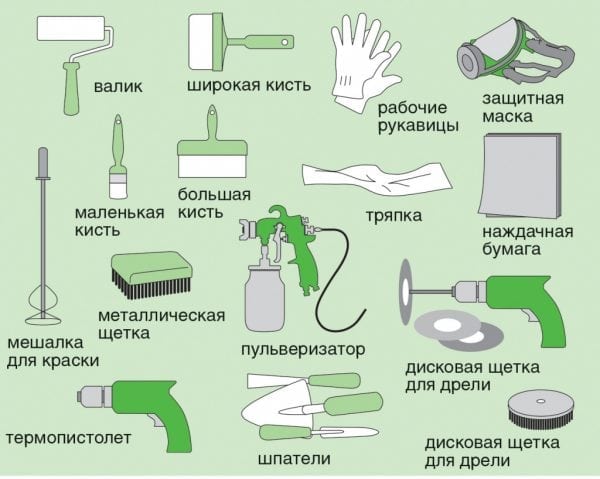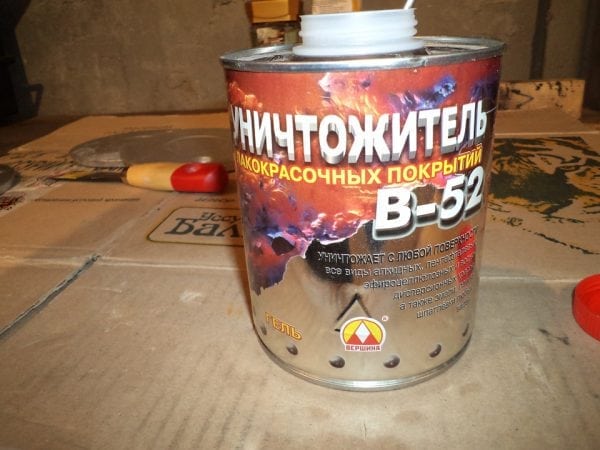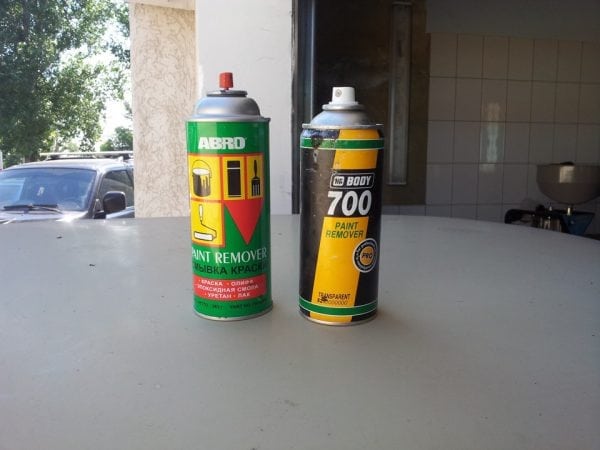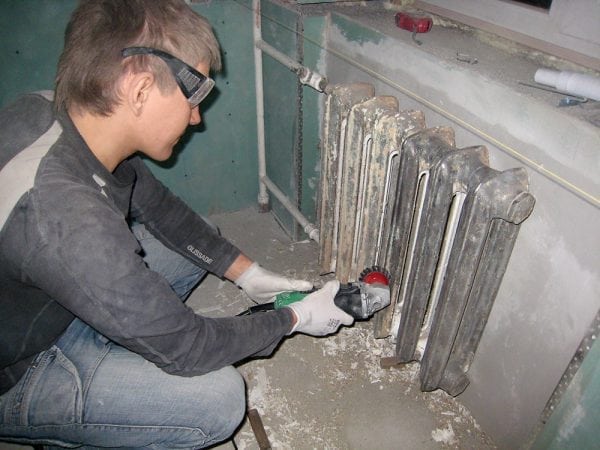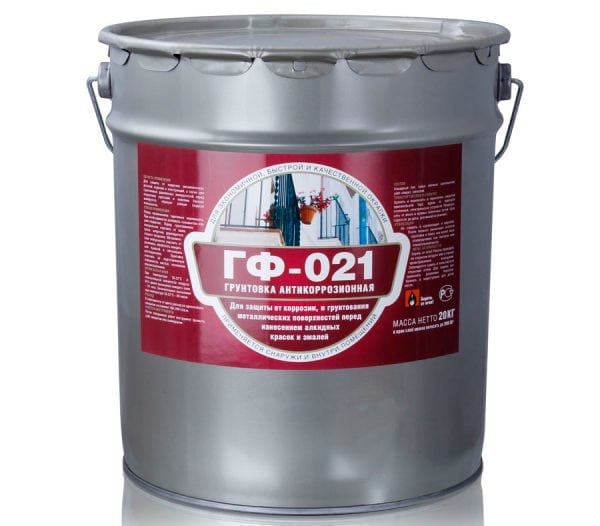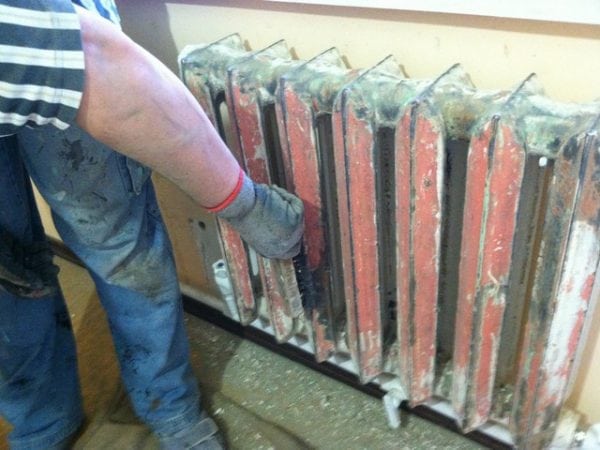If the radiator is not new, before painting, remove the layer of old paint. This is a rather time-consuming process, but there is simply no other way to turn the battery into a modern interior element.
- Paint Removal Preparation
- Paint Removal Methods
- Chemical option
- Aerosols
- Thermal method
- Mechanical way
- Powder paint removal
- Security measures
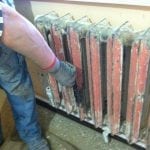
You can remove old paint from heating radiators by several methods, including thermal, mechanical and chemical.
Paint Removal Preparation
It is recommended that you begin cleaning the battery immediately before repair, when the walls and floor are already prepared. If the paint is removed after the repair is completed, it is recommended to cover nearby surfaces with plastic wrap or paper. If this is not done, chemicals, dust and hot air will damage the coatings.
To remove paint you need such tools and devices:
- metal spatula;
- wire bristle brush;
- rags or unnecessary rags.
Advice! It is more correct to remove the battery and take it out to fresh air to remove paint there.
Whichever method for removing the paintwork is chosen, you need to take care of your own safety. Gloves made of rubber or dense fabric will be required, since you will have to work with a solvent. Need goggles and a respirator.
Before removing the old paint coat, turn off the heating. Cleaning a hot radiator is not only inefficient, but also dangerous when it comes to the use of chemicals.
to contents ↑Paint Removal Methods
Chemical option
A wide range of chemicals for cleaning the surface of old paint is on sale.
Chemicals are available in different concentrations, however, conditionally all liquids can be divided into 2 types:
- aerosols;
- liquid formulations.
For plate radiators, liquid washes are recommended. First, a wash is applied to the radiator for 15 to 20 minutes. When the coating begins to bubble, the enamel is removed with a spatula, and then the residues are cleaned with a metal brush. At the end, the surface is thoroughly wiped with a rag.
Note! Chemicals for cleaning paint should not be kept in plastic containers. If you need to pour liquid from the factory packaging, it is recommended to use a glass container. When work is completed and the tank is no longer needed, it should be disposed of.
Chemical washes are only effective when it comes to radiators stained with 1 to 2 layers. If there are 8 - 10 layers on the metal, then each layer will need to be removed separately. It will take a lot of time and effort to get the result.
Given the dangers of working with chemicals, it is recommended to abandon chemical cleaning when it comes to multilayer coatings.
Another feature of working with washes - compositions can destroy rubber intersection gaskets. As a result, the radiator will leak. Based on the foregoing, the joints should not be treated with a solvent.
to contents ↑Aerosols
Aerosols are chemical paint removers. Aerosol chemicals are most practical for cleaning cast iron batteries. Spraying allows you to reach hard to reach surfaces.
Note! Before applying the chemical composition to the metal, all plastic or rubber objects must be removed from the working area. The floor should be protected with oilcloth.
Instructions for cleaning metal with aerosol:
- Spray aerosol over the surface. For processing the radiator (its external and external parts), one spray is enough.
- After about 15 to 30 minutes, the finishing layer is covered with blisters. The reaction rate depends on the air temperature.
- Remove loose paint from the battery. It is easiest to clean the batteries of old loose paint with a metal brush.
If the paint layer could not be removed after the first procedure, after some time it is recommended to repeat the cleaning.
to contents ↑Thermal method
The technique is based on heating the enamel layer with hot air from an industrial hair dryer. Due to heating, the coating exfoliates from the metal. The dilapidated coating is removed using a spatula or a metal brush.
However, if you need to remove several layers of paint, a hairdryer is not the best option. In this case, it is recommended to use a blowtorch, which quickly heats up the old paint layer to the boiling point. Hazardous substances will be released into the environment, so work must be carried out in the fresh air and in protective equipment.
to contents ↑Mechanical way
This cleaning method is the easiest to execute, but at the same time time consuming, time consuming. It is especially difficult to clean off paint residues in hard-to-reach places, for example, on the edges of batteries.
Mechanical cleaning consists in removing the enamel layer with a metal tool (spatula, brush, electric drill, angle grinder). Coarse sandpaper is also used.
The relief surfaces on cast iron batteries are recommended to be cleaned using special tools (for example, a wire brush for a drill).
Before starting work on mechanical cleaning, it is recommended that you take care of your own safety. During cleaning, a large amount of fine particles and dust are separated from the coating. To protect yourself, wear special glasses, gloves and a respirator. It is advisable to close all doors to neighboring rooms and open the windows in the room.
to contents ↑Note! Immediately prior to mechanical removal of the paintwork, it is not recommended to treat the surface with chemicals.
Powder paint removal
If it’s not so difficult to remove old paint from a cast-iron battery, it is much more difficult to remove the powder coating. A smooth polymer surface will clearly interfere with good adhesion with the new paint.
To solve the problem, only one method is suitable:
- Partial paint removal using coarse-grained sandpaper.
- Primer surface.
When the glossy coating is removed, the surface must be degreased with white spirit or any other solvent. Subsequent actions depend on the type of new coating. For example, silicone or heat-resistant enamels can be applied on a bare metal base, but for alkyd and acrylic paints you need a well-prepared base to ensure adhesion.
Advice! Priming the base is recommended in any case, as this will extend the operational life of the coating.
The most popular brand of primer is GF-021. Such a primer is used before applying paints based on acrylates and alkyd resins.GF-021 is most often red-brown in color, but there is also a gray primer of this brand.
to contents ↑Security measures
Removing paint requires safety measures. Regardless of the cleaning method chosen, protective clothing, goggles and a respirator should be used. Of particular potential danger to human health is chemical treatment.
When working with chemicals, a number of circumstances need to be considered:
- Chemicals are caustic. Contact with skin and mucous membranes can cause burns and severe irritation.
- Solvents are toxic. When working with such substances, it is necessary to ventilate the room or provide good ventilation in it.
- It is recommended to protect against chemicals not only your own body, but also the floor covering, household items made of plastic and rubber.
In terms of process simplicity and safety, old paint is easiest to remove mechanically. The thermal method is effective, but not accessible to everyone.
If the paintwork is not thick and there are all safety features, chemical surface treatment can be applied.

